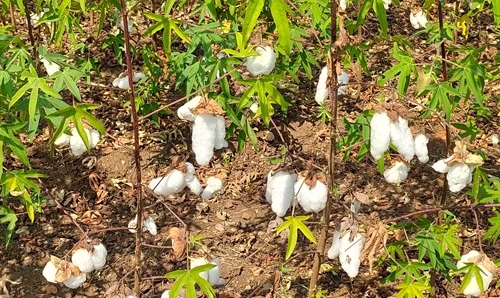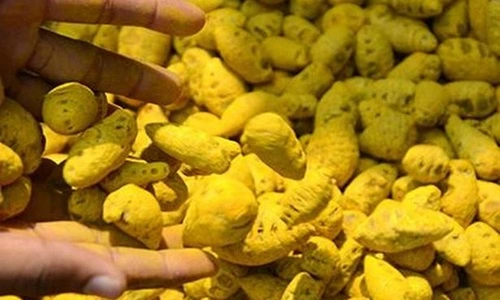Cotton, often referred to as the “White Gold”, is one of the most important cash crops in India, supporting millions of farmers and driving the textile industry. India is the largest producer of cotton globally, contributing significantly to the global textile and apparel sector. Major cotton-producing states in India include Gujarat, Maharashtra, Telangana, Andhra Pradesh, Tamil Nadu, Punjab, and Haryana.
Cotton cultivation in India includes desi (indigenous) varieties, American upland cotton (Gossypium hirsutum), and hybrids, including genetically modified varieties like Bt Cotton. Indian farmers rely on specific cotton varieties that offer high yields, disease resistance, fiber quality, and adaptability to diverse agro-climatic conditions.
In this article, we will explore the top cotton varieties grown in India, their characteristics, cultivation regions, and commercial importance.

1. BT Cotton (Bollgard I and Bollgard II)
Bt Cotton is a genetically modified (GM) cotton variety resistant to the bollworm pest. Introduced in the early 2000s, it revolutionized cotton farming in India by increasing yields and reducing pesticide use.
- Type: Genetically Modified Hybrid
- Regions: Gujarat, Maharashtra, Andhra Pradesh, Telangana, Punjab
- Characteristics:
- Resistant to bollworms
- High yield potential
- Lower pesticide dependency
- Uses: High-quality textile production
2. Gossypium Hirsutum (American Cotton)
Gossypium hirsutum is widely cultivated in India and accounts for 80% of the country’s cotton production. Known for its long staple fiber, it is ideal for fine quality textiles.
- Type: American Upland Cotton
- Regions: Gujarat, Maharashtra, Punjab, Tamil Nadu
- Characteristics:
- High lint yield
- Medium to long staple fiber
- Suitable for spinning fine yarn
- Uses: Textile industry, apparel production
3. Suraj (G. arboreum)
Suraj is a popular desi cotton variety known for its adaptability to rainfed conditions and resistance to pests and diseases. It is a preferred variety in drought-prone regions.
- Type: Indigenous (Desi) Variety
- Regions: Maharashtra, Gujarat, Madhya Pradesh
- Characteristics:
- Drought-tolerant
- Short staple fiber
- Resistant to diseases like leaf curl virus
- Uses: Coarse textiles, handlooms
4. LRA 5166
LRA 5166 is a medium-staple cotton variety widely grown in Tamil Nadu and Maharashtra. It is popular for its consistent yield and resistance to pests.
- Type: Hybrid Variety
- Regions: Tamil Nadu, Maharashtra
- Characteristics:
- Medium staple fiber (24–26 mm)
- High yield
- Suitable for diverse climatic conditions
- Uses: Textile production, yarn spinning
5. H-4 Hybrid
H-4 is the first cotton hybrid variety developed in India by CICR (Central Institute for Cotton Research). It is known for its long staple fiber and high yield.
- Type: Hybrid Variety
- Regions: Gujarat, Maharashtra, Andhra Pradesh
- Characteristics:
- Long staple fiber (27–29 mm)
- High yield and uniformity
- Tolerant to pests and diseases
- Uses: Fine quality textiles
6. Shankar-6
Shankar-6 is one of the most popular long-staple cotton varieties grown in India. It is highly sought after in both domestic and export markets for its superior fiber quality.
- Type: Hybrid Variety
- Regions: Gujarat, Maharashtra
- Characteristics:
- Long staple fiber (30–32 mm)
- Strong and fine fiber
- High market demand
- Uses: Premium textiles, export-quality yarn
7. Bunny Bt Cotton
Bunny Bt is a genetically modified cotton variety that offers high yield and resistance to bollworms. It is widely grown in Telangana and Andhra Pradesh.
- Type: Bt Hybrid
- Regions: Telangana, Andhra Pradesh
- Characteristics:
- High yield potential
- Resistant to bollworms
- Good adaptability to rainfed conditions
- Uses: Commercial cotton production
8. Ankur 651
Ankur 651 is a hybrid cotton variety known for its early maturity and high productivity. It is widely grown in central and southern cotton belts.
- Type: Hybrid Variety
- Regions: Maharashtra, Gujarat, Karnataka
- Characteristics:
- Early maturity (120–140 days)
- Medium staple fiber
- Good pest tolerance
- Uses: Yarn spinning, textile industry
9. RCH-2 Bt Cotton
RCH-2 Bt is another popular Bt cotton variety known for its resistance to bollworms and high yield. It has gained significant preference among farmers.
- Type: Bt Hybrid
- Regions: Gujarat, Maharashtra, Andhra Pradesh
- Characteristics:
- Long staple fiber (27–29 mm)
- Bollworm resistance
- High productivity
- Uses: Quality textile production
10. MCU-5
MCU-5 is a popular long staple cotton variety grown predominantly in Tamil Nadu. It is highly valued for its fiber strength and fine quality.
- Type: Long Staple Variety
- Regions: Tamil Nadu, Karnataka
- Characteristics:
- Long staple fiber (32–34 mm)
- Strong fiber with good luster
- Resistant to common pests
- Uses: Premium textile production
FAQs
Q1: Which is the most popular cotton variety in India?
A: Bt Cotton (Bollgard I and Bollgard II) is the most popular variety due to its high yield and pest resistance.
Q2: What is the difference between desi cotton and hybrid cotton?
A: Desi cotton (e.g., Suraj) is indigenous, drought-tolerant, and has short fibers, whereas hybrid cotton (e.g., H-4, Shankar-6) has high yield, long fibers, and improved resistance to pests.
Q3: Which cotton variety is best for export?
A: Shankar-6 and Suvin are widely exported due to their superior fiber quality and long staple length.
Q4: What is Bt Cotton, and why is it significant?
A: Bt Cotton is a genetically modified variety resistant to bollworms, leading to reduced pesticide use and higher productivity.
Q5: Which states are the leading cotton producers in India?
A: Gujarat, Maharashtra, Telangana, Andhra Pradesh, Tamil Nadu, and Punjab are the top cotton-producing states in India.
Conclusion
India’s cotton sector is diverse and dynamic, offering farmers a wide range of indigenous, hybrid, and Bt varieties suited for different climatic conditions and market needs. Varieties like Shankar-6, Suvin, and MCU-5 cater to premium markets, while high-yielding hybrids like Bt Cotton dominate commercial farming. Cotton cultivation remains a pillar of Indian agriculture, supporting rural livelihoods and driving the textile industry forward.

